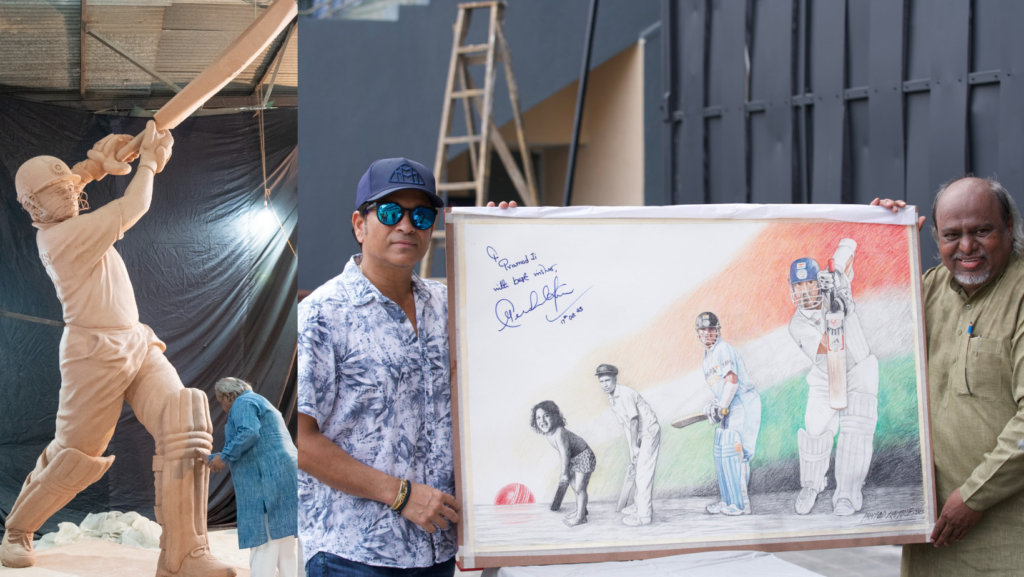Subhayan Chakraborty at the Wankhede Stadium, Mumbai
As cricket enthusiasts around the globe gear up for the highly anticipated ICC Men’s ODI World Cup match between India and Sri Lanka at the Wankhede Stadium – a repeat of the celebrated final at the same venue on April 2, 2011 – there’s an extra touch of magic being added to the iconic venue. On the eve of this match, a life-sized statue of Sachin Tendulkar, India’s greatest cricketer, is set to be unveiled.
It marks the realisation of a long-awaited tribute to the Master, who turned 50 last April. The statue, carefully created to depict Tendulkar in action, with a poised stroke at the crease, is positioned adjacent to the Sachin Tendulkar Stand at the stadium.
The statue is the handiwork of Pramod Kamble, a painter-sculptor hailing from Ahmednagar, Maharashtra. The fine detailing and precision involved in creating this tribute to Tendulkar is a testament to the Kamble’s dedication and craftsmanship.
“I have known Sachin sir for many years,” he told RevSportz. “He has seen and appreciated my work in the past. When the MCA announced that it would install a life-sized statue of him at the Wankhede Stadium, I was telling my family members that it would be a once-in-a-lifetime opportunity for us. Interestingly, I got a call from the MCA a few days later to discuss this project. It was unbelievable. Later, I came to know that Sachin sir had himself recommended my name. It was surreal. To be associated with the ‘God of Cricket’ is a dream. I gave my everything to bring this statue to life. With this, my craft has been immortalised.”
Kamble hailed Ajit Tendulkar, Sachin’s elder brother, for playing a pivotal role in bringing a simple idea to fruition. “We had discussed a few shots and celebrations at length, but zeroed in on this,” said Kamble. “I ordered special clay from Japan for the model which was to be approved for the main statue. It took me eight months, multiple meetings with Ajit sir and then with the MCA authorities for the final model to be approved. Ajit sir was extremely helpful in explaining to me the importance of balance in boot shape and positioning, and the bat as well. How the gloves should be and minor details. Without him, this wouldn’t have been possible.”
The statue’s placement at the Wankhede Stadium is significant for other reasons too. Tendulkar didn’t just win the World Cup there. He also played his farewell Test there in November 2013, against West Indies.
“I’ll be forever grateful for this opportunity,” said Kamble. “It has been installed in such a position that during every match, every event, people will be able to witness it. We have all been Sachin Tendulkar devotees, and I hope my work will justify what the legend has done on and off the cricket field.”
The statue is set to be inauguarated by Eknath Shinde, Maharashtra Chief Minister, and Devendra Fadnavis, his deputy, alongside Tendulkar himself. Jay Shah, Secretary of the Board of Control for Cricket in India (BCCI), and Ashish Shelar, its treasurer, will also grace the occasion. The Mumbai Cricket Association (MCA) will be represented by Amol Kale, its president, Ajinkya Naik, the secretary, and other members of the apex council.
Tendulkar’s legacy continues to inspire countless individuals, both within India and outside India. The unveiling of this statue at his home ground, the Wankhede Stadium, adds yet another chapter to his remarkable journey. It will ensure that his matchless contribution to the sport remain etched in the hearts of cricket aficionados for generations to come.




